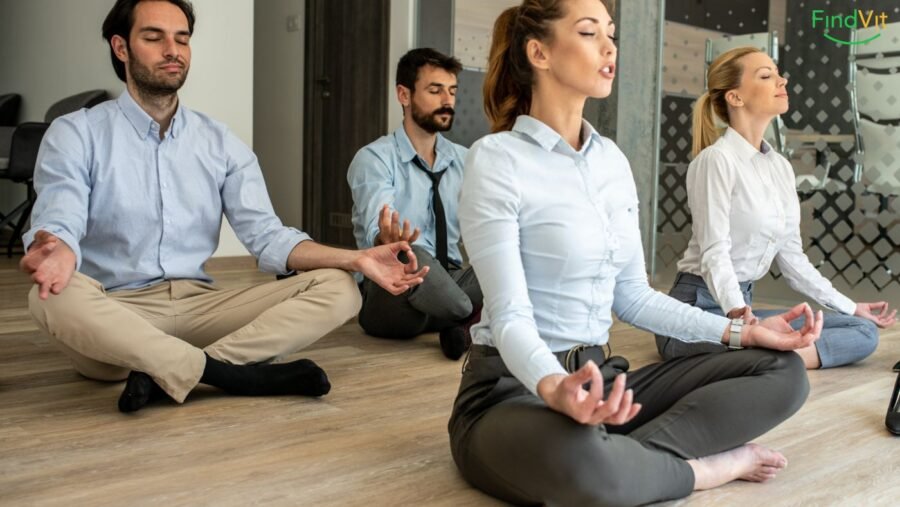We often give in to the illusion that rest is the reward for hard work. But what if the true path to peak productivity lies not in whether we've worked hard enough to deserve rest, but more importantly, whether we've rested enough to perform at our best?
This crucial shift in attitude is at the heart of the practice of non-sleep deep rest (NSDR), a transformative methodology that redefines our approach to relaxation and recovery. Popularized by neuroscientists (such as Andrew Huberman), NSDR is a practice that induces a state of deep relaxation, similar to sleep, while remaining conscious.1
Drawing inspiration from yoga nidra, hypnosis and other practices, NSDR is not just a pause in our busy lives. It is a science-based methodology that allows us to recharge our metaphorical "batteries". So let's take a look together at how NSDR can transform your concept of rest and reveal its importance in achieving mental and physical well-being and peak results in everyday activities.
What is Non-Sleep Deep Rest (NSDR)?
The relaxation technique "sleepless deep relaxation" (NSDR) is rapidly gaining popularity. The term was coined by Andrew Huberman, a neuroscientist and professor at the Stanford School of Medicine, who has discussed NSDR extensively on the popular Tim Ferriss and Joe Rogan podcasts. A number of famous personalities, including Google CEO Sundar Pichai, claim to practice this technique.
The practice of Non-Sleep Deep Relaxation (NSDR) is a unique technique that helps you achieve a state of deep relaxation similar to sleep, while remaining conscious. This technique includes a variety of exercises, such as directed breathing, visualization and focus, which help to reduce the activity of the sympathetic nervous system and activate the parasympathetic nervous system.
Cute the nervous system is responsible for the stress response known as the "fight or flight" response. Meanwhile parasympathetic the nervous system regulates the relaxation process, also known as the "rest and digest" response. By reducing the activity of the sympathetic nervous system and activating the parasympathetic system, NSDR practice can help achieve a state of deep relaxation, reduce stress and anxiety. NSDR can promote feelings of relaxation by increasing dopamine levels in the brain, while also lowering heart rate and blood pressure.
We'll delve into how NSDR works, compare it to yoga nidra, discuss potential benefits, and provide tips on how to practice.

5 Advantages of NSDR
As may be clear from a brief review of the research, NSDR offers a variety of benefits that contribute to mental and physical health. The following benefits demonstrate the profound impact of NSDR on improving overall quality of life indicators:
Reduced stress and anxiety
One of the most important benefits of NSDR is its ability to reduce stress and anxiety levels. As mentioned earlier, meditation, one of the main components of NSDR, is effective in reducing cortisol, the main stress hormone, thereby reducing the overall effects of stress (Goyal et al., 2014). This is especially true in our fast-paced, stressful society where chronic stress is commonplace.
Improved cognitive function NSDR is associated with improved cognitive function; mindfulness meditation can increase connections in the brain's zero-state network associated with better memory, attention, and self-reflection abilities (Lutz et al., 2004). This can lead to better performance in both personal and professional life.
Improved sleep quality
Yoga nidra practices, as shown by Datta et al. (2021), can improve sleep quality and reduce insomnia symptoms. This improvement in sleep can be especially beneficial for people who suffer from sleep disorders.
Increased psychological well-being Regular NSDR practices can improve symptoms of anxiety, depression, and pain (Goyal et al., 2014). This development of mental health is the key to overall well-being.
Physiological benefits
NSDR has been associated with various physiological benefits, including lower blood pressure, decreased heart rate (Anderson et al., 2008), as well as improved immune system function (Morgan et al., 2014). These changes contribute to a lower risk of chronic disease and a healthier, more resilient body.

NSDR compared to yoga nidra
A. Huberman originally coined the term "sleepless deep rest" (NSDR) as a more westernized name for the ancient Eastern practice of yoga nidra. After learning about the power of yoga nidra, he wanted to introduce the practice to a wider audience that might be put off by the spiritual connotations of the term.
Yoga nidra, also called the practice of yogic sleep or mental sleep, involves lying on your back and listening to special visual guides. The goal of yoga nidra is a state of complete peace. By practicing yoga nidra, people can enter a deeply relaxed state of consciousness, similar to sleep, while remaining awake.
Over time, A. Huberman expanded the definition of NSDR, turning it into an umbrella term that includes various types of deep relaxation. According to this expanded definition, yoga nidra is one of the varieties of NSDR, along with other practices such as hypnosis and types of meditation.
Is NSDR superior to naps (short naps)?
Scientists have yet to directly compare the NSDR and the short day nap. However, A. Huberman has hinted that the pod may function similarly to the NSDR.
How to practice NSDR?
People usually practice NSDR while lying down and listening to audio or video instructions online. Huberman's NSDR protocol involves sitting or lying with eyes closed and listening to instructions for visualization and breathing exercises. It is important to practice NSDR in a comfortable, quiet environment, free of possible distractions. Calming scents, a weighted blanket, or even a white noise machine can help focus your meditation. It's essential to wear comfortable, loose-fitting clothing so that you can fully concentrate on the exercise.
NSDR practice can be done in many ways, but it usually involves the following steps:
- Prepare the right environment: Choose a quiet, comfortable place free of distractions. You can use candles, scents or calm music to create a relaxing atmosphere.
- Make yourself comfortable: You can sit or lie on your back, the main thing is that your position is comfortable and relaxed.
- Use a lead entry: Many people find it helpful to listen to a guided NSDR recording of breathing techniques, visualizations, and other exercises.
- Focus on your breathing: One of the main parts of NSDR practice is focused breathing. Try to breathe slowly and deeply, following the guide's instructions.
- Do visualization exercises: NSDR's editorials often include visualization exercises that help take your mind off your daily worries and immerse you in a state of relaxation.
- Allow yourself to relax: Finally, just relax and allow yourself to experience deep relaxation. Remember that NSDR is not sleep, so your consciousness remains alert, albeit very relaxed.
It is important to practice NSDR regularly for best results. Even just a few minutes a day can help reduce stress and improve your overall well-being.

Consistent practice
As with most practices, consistency is the key to NSDR meditation. Regular practice enhances its benefits, allowing you to reach a deeper level of relaxation and mindfulness. Even a few minutes every day can make a big difference.
One of the main advantages of NSDR is that it can be practiced for short periods of time per day and still experience benefits. This can be especially helpful for busy people who find it difficult to find time for long meditation sessions.
Additionally, NSDR can be helpful for those who have difficulty concentrating during meditation. Guided NSDR recordings can help you maintain focus and sink into a state of relaxation.
For sleep quality
One of the most important areas of NSDR is its impact on sleep quality and recovery. Gross et al. (2011) showed that a mindfulness-based stress reduction program, a type of NSDR technique, improved sleep patterns and reduced insomnia symptoms. This highlights the therapeutic potential of NSDR practitioners similar to sleep.
In addition, NSDR can be beneficial for those who do not get enough sleep for various reasons. This practice allows you to experience some of the benefits of sleep, such as relaxation and recovery, even if you can't sleep through the night.
Improving performance
Practicing NSDR can be beneficial not only for personal well-being, but also for improving performance. Research shows that NSDR can improve focus, memory, and cognitive flexibility, which are important factors for productivity at work and in everyday tasks.
In addition, NSDR can help reduce stress and anxiety, which often interfere with performance. When you are relaxed and focused, you will be able to focus better on tasks and perform them more efficiently.
Health practices
NSDR goes well with other health practices such as yoga, physiotherapy or traditional Chinese medicine. These practices often include breathing and relaxation exercises, which are important elements of NSDR.
By combining NSDR with other wellness practices, you can achieve even better results and experience more benefits for your physical and mental health. For example, NSDR can help you relax more deeply after yoga or a massage session.

Meditation
Although NSDR and meditation share similarities, they are not identical practices. Meditation often involves focusing attention on the breath or another object, whereas NSDR is a more guided practice that uses visualization and body scanning exercises.
However, NSDR and meditation can go well together. For example, you might start your day with a short meditation session, followed by an NSDR practice for deeper relaxation and recovery.
For stress management
One of the main benefits of NSDR is its ability to reduce stress and feelings of anxiety. This practice helps activate the parasympathetic nervous system, which is responsible for relaxation, and lowers levels of the stress hormone cortisol.
Regular practice of NSDR can help you better manage stress and avoid its negative consequences, such as fatigue, migraines, insomnia or depression. In addition, NSDR can help you learn to recognize the signs of stress and take steps to reduce them.
Emotional health
NSDR practice can have a positive effect not only on physical health, but also on emotional health. Research shows that this practice can reduce symptoms of depression and anxiety, as well as improve overall emotional well-being.
The state of deep relaxation we achieve during NSDR can help reduce negative emotions and improve emotional stability. In addition, this practice can help you learn to manage stress and anxiety, which often lead to emotional difficulties.
NSDR and a healthy lifestyle
NSDR is a great addition to a healthy lifestyle. This practice can be combined with other health care measures such as proper nutrition, physical activity and adequate rest.
For example, you can start your day with a short NSDR session, followed by exercise or a nature walk. Alternatively, you can practice NSDR before bed to help you fall asleep and improve the quality of your sleep. By combining NSDR with other health care measures, you can achieve optimal well-being and maintain a positive outlook on life.
NSDR and spirituality
Although NSDR is not directly related to spirituality or religion, the practice can help you achieve deeper awareness and inner peace. The state of deep relaxation we experience during NSDR can help us let go of our daily worries and focus on the present.
Some people may experience spiritual renewal or deeper awareness when practicing NSDR. However, it is important to remember that this practice is secular and independent of any specific spiritual tradition or belief system.
NSDR research and studies
The concept of NSDR is receiving increasing attention from scientists, with various studies examining its effects on mental health, cognitive functions, and general well-being. Research in this area is particularly focused on how NSDR practices such as meditation, yoga nidra, and guided relaxation affect physiological and psychological processes.
Reducing stress and anxiety
One of the main areas of research is the effect of NSDR on stress and anxiety reduction Systemic

FAQ Part: "Insomnia Deep Rest NSDR"
What is NSDR and how does it relate to sleep?
NSDR, or non-sleep deep rest, is a state where the body recovers not through sleep, but through relaxing activities such as meditation, deep breathing exercises, or yoga poses. This state helps to reduce stress, restore energy levels and improve emotional state.
Can NSDR replace sleep?
Although NSDR is beneficial for body regeneration, it should not be used as the sole means of rest. A good night's sleep is essential for good health, and NSDR can be used as an additional way to relax and restore strength.
What are the best ways to practice NSDR?
The most effective methods of NSDR include various relaxation activities. It can be deep breathing, meditation, yoga exercises or even a simple moment of silence in nature. It is important to find the most suitable method for you, which will allow you to achieve maximum relaxation.
Is there scientific evidence to support the benefits of NSDR?
Research shows that relaxing activities that stimulate the NSDR state can reduce stress, improve mood, and even help reduce inflammation in the body. Regular practice of NSDR has also been found to improve a person's overall emotional health and well-being.
NSDR and the pursuit of perfection
Although NSDR is not directly related to environmental issues, the practice can help develop a sustainable approach to life. The state of deep relaxation that we achieve by practicing NSDR can help us get rid of excess worries and focus on what is truly important.
In addition, NSDR can help develop awareness and focus, which are important for understanding one's environmental impact and making more sustainable decisions. This can help reduce waste, save resources and live in harmony with nature.
In conclusion, the practice of non-sleep deep relaxation (NSDR) can have a wide range of positive effects in many areas of life. From managing stress to cultivating creativity, this unique technique can help you achieve deeper awareness, relaxation, and inner peace. So why not try NSDR and use its benefits in your everyday life?













